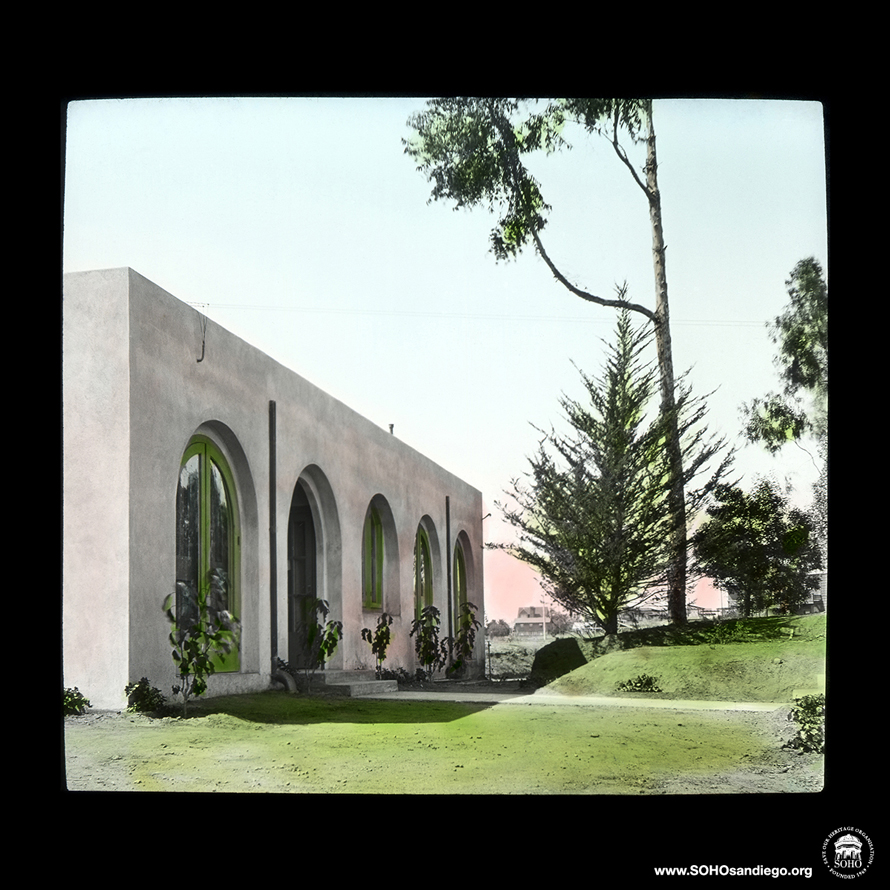|
Irving Gill's Glass Slide Photographs
A COLLECTION OF GLASS SLIDES that create luminous photographs of Irving Gill's work around 1910 was found in a garage in San Diego when two patinated oak carrying cases surfaced at a former home of Louis Gill, Irving's nephew and partner in Gill & Gill. Unseen for decades approaching a century, the images are being presented here for the first time. Each one is a unique print.
 are included here, in black-and-white or gently hand-tinted images. Originally, they were part of a larger set; this curated selection offers a graceful entrée into the realm of Gill's houses, churches and school buildings. are included here, in black-and-white or gently hand-tinted images. Originally, they were part of a larger set; this curated selection offers a graceful entrée into the realm of Gill's houses, churches and school buildings.
The rarity of the glass slides is magnified due to their fragility. Miraculously, they survived a century without being cracked, damaged, or lost.
Originally, the glass slides would have been projected through a magic lantern for clients or for educational purposes. Magic lanterns were most popular during the first three decades of the 20th century, so it is significant that Gill chose advanced technology of the day to present and record his work.
These images have a soft, turn-of-the-century aura that makes them especially beautiful as well as evocative of a time when San Diego was poised to become a city. The domestic interiors of the Thomas Hamilton/Mary Fulford and Annie B. Darst houses are as intriguing for their furnishings as for the play of light and tracery of vines that Irving Gill envisioned when he initially designed them. He must have taken special pleasure in the hammock hanging in a breezeway at Mary Fulford's because he himself slept in a suspended bed around this time in one of his experimental cottages. Gill's bed could be raised to make more room for daytime living.
As if in homage to San Diego's glorious sunshine, light and shadow almost seem choreographed as they move across conspicuously plain walls and through arch after arch in this photography collection. Referring to old Southwest buildings, Gill's friend Pauline Gibling Schindler said, "He loved the light on their white adobe walls. He spoke of the delight he felt in the color of the shadows on the white. That… came from the California desert, the sunlight itself."
The formal composition of another image reveals something else telling about Gill, who may have been on site when these photographs were taken. The photograph portrays a Bishop's School building on the La Jolla campus. The building's arched doors, arcade and red-tinted concrete floor are pure Gill. So is his desire for pristine exteriors devoid of ornament and any interruption of his meticulous geometry. But here we have scattered floor mats, presumably pushed this way and that by oblivious youth—by life itself, in other words. No wonder the Bishop's School kept inviting Gill back to design more buildings.
This is not the first time photography of Gill's buildings has materialized at an auspicious moment for public enrichment. In 1958, an Irving Gill retrospective comprised of photographs by Marvin Rand and a legendary catalog essay by Esther McCoy is credited with awakening a new generation to Gill's accomplished work in Southern California. The retrospective was seen at the Art Center of La Jolla (now the Museum of Contemporary Art San Diego) and the Los Angeles County Museum. A longer version of McCoy's engaging writing on Gill, from Five California Architects (1960), is reprinted elsewhere in this catalog.
More than a century has gone by since Gill likely stood with a commercial photographer to capture these insightful views of his then-new buildings. If we cannot visit a building, seeing it through the eyes of a gifted architect is the next best thing to being there.
These rare glass slide photographs are the collection of Bruce and Alana Coons, collectors of early San Diego photography.
-Written by Ann Jarmusch originally for Irving Gill: Progress & Poetry in Architecture, 2017
|

